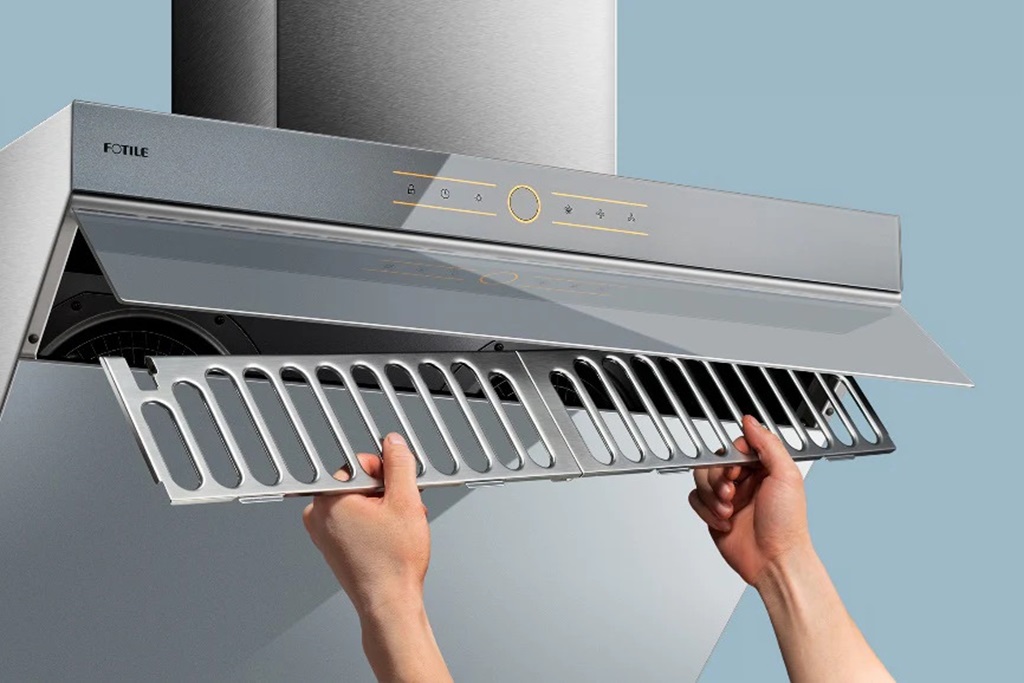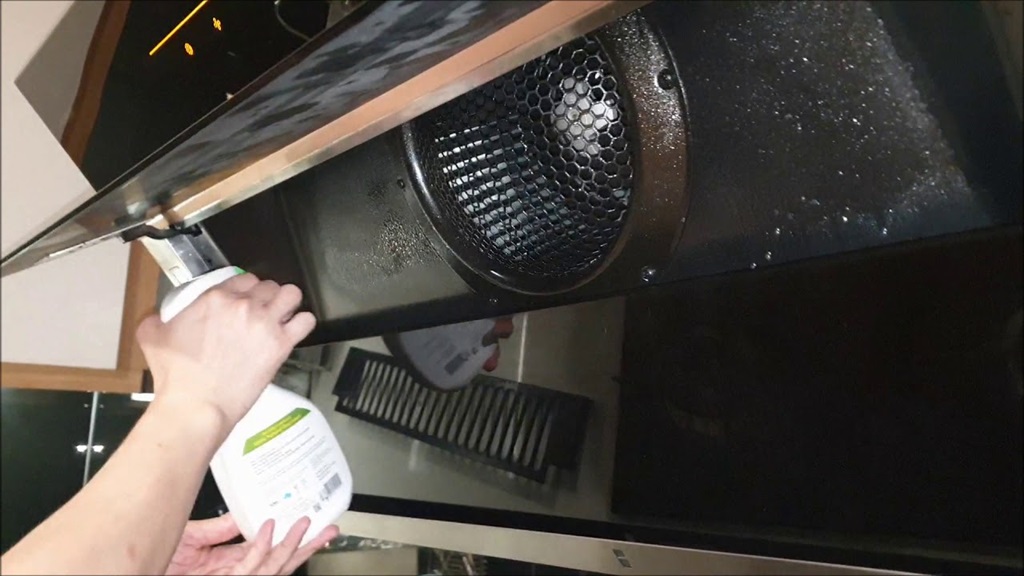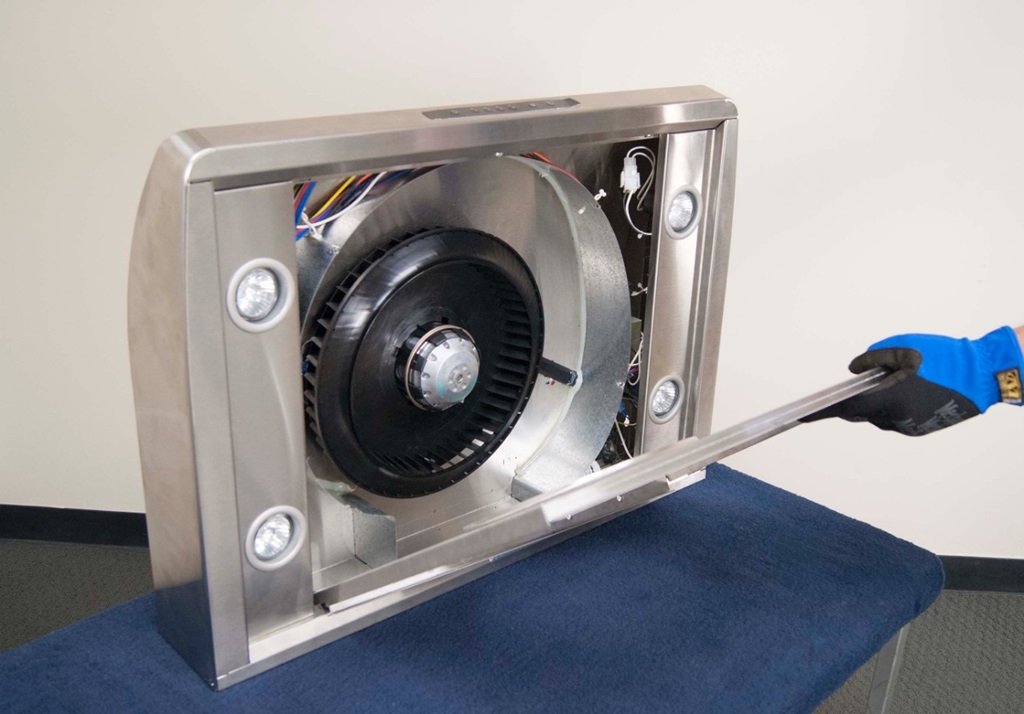
24 Feb How to Clean Range Hood Fan Motor?
Cleaning the fan motor of your range hood is an important maintenance task that should be done regularly to keep your kitchen appliances functioning properly and your home safe. Grease, dust, and grime can build up on the fan motor over time, reducing its efficiency and even creating potential fire hazards.
Don’t worry – with the right techniques and tools, cleaning your range hood fan motor can be a straightforward DIY task. I’ll walk you through the entire process step-by-step, from what you’ll need to do beforehand, to how to clean range hood fan motor. We’ll also cover maintenance tips to prevent future buildup.
Preparing to Clean the Range Hood Motor
Before diving into the cleaning process itself, there are a few preparatory steps to take for an efficient and thorough motor cleaning job:
Turn Off Power to the Range Hood
Safety first! Before any cleaning, be sure to turn off the power to your range hood at the circuit breaker. This will prevent any risk of shock while you’re working on the electrical motor assembly.
Remove the Fan Blades
The removable metal fan blades (and blade brackets if applicable) will need to be detached from the motor shaft for full access. Consult your range hood manual if needed, as removal methods vary. Set blades carefully aside where they won’t get bent or damaged.
Take Down Metal Filters, Baffle, and Vent Covers
Remove and set aside any metal mesh filters, angled metal baffle filters or decorative vent covers on your hood. This gets them out of the way for cleaning and allows access to the motor housing.
Gather Supplies
Have ready supplies like rags, scrub brushes, gloves, a vacuum, replacement filters/parts, and motor degreaser solution. Mild dish soap with warm water can work for grease buildup. Avoid harsh chemicals.
Protect Surrounding Area
Place towels or sheets below the range hood to catch drips and debris. You may also want to cover nearby appliances and surfaces to protect them from splatters.
Step-by-Step Guide to Cleaning a Range Hood Motor

Now we’re ready to clean! Follow these steps to thoroughly scrub every inch of your range hood fan motor:
Wipe the Exterior Hood Surfaces
With a soft cloth, mild detergent, and warm water, wipe down all reachable exterior surfaces of the range hood – side panels, control panel, underside, etc. This cleans general kitchen grime before you dive into the motor.
Remove the Motor Mounting Plate
The fan motor is secured inside the hood with a mounting plate. Unscrew this panel to access the motor. Save all small screws and parts for reassembly later. Use a vacuum crevice tool to suck out dust before proceeding.
Scrub the Motor Casing Exterior
Check the motor casing (metal exterior housing) for grease buildup. Use a scrub brush with warm, soapy water to clean the casing thoroughly if needed. Avoid submerging the motor in water.
Detach and Clean Fan Blade Brackets
Unscrew blade brackets from the motor shaft. Soak these in a degreaser solution to loosen cooked-on grime. Scrub well and rinse clean before the reinstallation.
Access and Clean Motor Interior
Your range hood may have an access panel on the side or back of the motor casing that can be unscrewed to reach the interior. Use a narrow scrub brush dipped in degreaser to gently clean inside the motor compartment. Be extremely careful not to damage any wiring or electrical components! Do not allow liquids to enter the motor interior.
Degrease the Motor Shaft
Buildup where the fan blades attach can lead to vibration and noise. Scrub the exposed motor shaft thoroughly with a small brush and degreaser solution. Later, add a thin coat of WD-40 to the shaft to discourage future grime.
Reattach Fan Blades
Once fully dry, carefully replace the cleaned fan blades onto the motor shaft in their original positioned order. Refer to arrows on the blades or your range hood manual as needed. Replace any mounting brackets.
Replace the Motor Mounting Plate
Screw the motor mounting plate back into place on the range hood interior to secure the motor. Make sure all wiring is correctly routed first.
Clean Range Hood Filters, Baffles, and Covers
While you have these removed, take the opportunity to soak and scrub any metal mesh filters or baffle filters in your sink with hot water and detergent. Rinse and allow to dry fully before replacing them in the hood. Wipe down decorative vent covers with a damp cloth.
Reconnect Power and Test
Reconnect power to your range hood at the circuit breaker. Turn on the fan at both low and high speeds to ensure proper operation. You may notice a reduction in noise from a well-cleaned motor.
Helpful Maintenance Tips for Range Hood Motors
Regular upkeep helps prevent major motor grime buildups down the line:
- Wipe the exterior hood surface weekly while cleaning your stove to prevent kitchen grease drips from baking on.
- Clean or replace metal mesh filters monthly according to your range hood manual. Clogged filters strain the motor.
- Vacuum loose debris from the filter recess and motor compartment every few months.
- Consider adding protective liners or drip trays that catch grease below the motor area.
- Inspect the motor casing, blades, and vents semi-annually for any new grime buildup. Spot clean as needed.
- Lubricate the motor shaft and blade brackets annually with WD-40 spray to maintain smooth spinning action.
- Professionally clean the entire range hood system every 2-3 years including motors, ducts, and vents.
Following regular maintenance along with proper ventilation use while cooking will keep your range hood fan motor running cleanly and efficiently for years!
Conclusion

Regularly cleaning your entire range hood system is essential not only for optimal function but also for safe home cooking. Over time, grease deposits on the fan motor can hinder airflow, breed bacteria, increase fire risk, and cause mechanical issues.
While it may seem daunting, this guide has outlined a straightforward process for thoroughly cleaning a range hood fan motor yourself. The task simply involves proper preparation, methodically working through each component, using the correct cleaning solutions, and safely accessing the motor interior.
Combined with good ventilation habits and regular maintenance, deep cleaning your range hood motor annually will support many years of smooth, quiet operation and healthier indoor air. With a little time and elbow grease, you can remove built-up grime and restore full performance to this hardworking kitchen appliance.
Frequently Asked Questions
1. How often should I clean the fan motor on my range hood?
It’s recommended to thoroughly clean your range hood fan motor at least once a year. Check it biannually for any grime buildup. Clean more frequently if your hood lacks adequate ventilation or you cook often with frying or high-heat methods.
2. What could happen if I don’t clean my range hood motor regularly?
Lack of cleaning can allow grease to bake, which strains the motor and creates excessive heat. This reduces fan efficiency and airflow. Significant buildup heightens the risk of motor failure or electrical issues. Grease is also a fire hazard.
3. Why does my range hood motor seem weaker or louder lately?
When a range hood motor sounds strained or less powerful, it usually indicates a need for cleaning. Built-up grime prevents the fan blades from spinning properly. Cleaning the motor can often reduce noise issues and restore airflow strength.
4. Can I just wipe my range hood motor with a wet cloth?
For light dust, a basic wipe-down is fine. However, grease accumulations require deep scrubbing with the proper degreaser solutions. Also, access the interior motor compartment for a thorough cleaning job. Avoid saturating the motor wiring and electronics.
5. Is it safe to remove the range hood motor myself?
As long as proper precautions are taken, it is safe for a homeowner to detach the motor, clean it thoroughly and reinstall it. Just be extremely careful working around the electrical components and wiring. Make sure to power off the range hood at the circuit breaker first. Consider hiring an electrician if you have any concerns about removing the motor.



Sorry, the comment form is closed at this time.